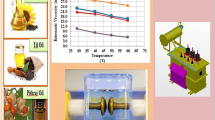Abstract
Maintenance of transformer oil is needed to maintain the quality of power service. Thermal heating and filtering are the main ways to remove contaminants from the oil. In this research, a preliminary study was carried out using microwaves as thermal heaters in the reconditioning process of used transformer oil. The reconditioning process is carried out by filtering and thermal heating varies from temperatures of 40–100 °C using a microwave oven. Dielectric characteristics are shown by analyzing breakdown voltage, dielectric power loss, viscosity, and dc conductivity measurements. The amount of moisture content is also taken into account in measuring the level of thermal efficiency of the heater. Under the influence of microwaves, an increase in the characteristics of the dielectric strength in the form of an increase in breakdown voltage reaches 140.50%. Microwave heating is very good in reducing the water content in oil with a level of thermal efficiency reaching 25.55–40.40%. Removal of contaminants is better done by microwaves characterized by a decrease in the value of the dielectric power loss and dc conductivity at each treatment.









Similar content being viewed by others
References
N’Cho JS, Fofana I, Beroual A, Aka-Ngnui T, Sabau J (2012) Aged oils reclamation: facts and arguments based on laboratory studies. IEEE Trans Dielectr Electr Insul 19(5):1583–1592
Okabe S, Ueta G, Tsuboi T (2013) Investigation of aging degradation status of insulating elements in oil-immersed transformer and its diagnostic method based on field measurement data. IEEE Trans Dielectr Electr Insul 20:346–355
Ueta G, Tsuboi T, Okabe S, Amimoto T (2012) Study on degradation causing components of various characteristics of transformer insulating oil. IEEE Trans Dielectr Electr Insul 19:2216–2224
Hadjadj Y, Fofana I, Van De Voort FR, Bussieres D (2016) Potential of determining moisture content in mineral insulating oil by fourier transform infrared spectroscopy. IEEE Electr Insul Mag 32(1):34–39
Liu J, Zhou L, Luo Y, Huang X, Wu G (2013) Dielectric frequency response of oil-paper composite insulation with transient moisture distribution. IEEE Trans Dielectr Electr Insul 20(4):1380–1387
Zhou Y, Huang M, Chen W, Jin F (2015) Space charge behavior of oil-paper insulation thermally aged under different temperatures and moistures. J Electr Eng Technol 10(3):1124–1130
Wada J, Ueta G, Okabe S, Amimoto T (2014) Method to evaluate the degradation condition of transformer insulating oil-experimental study on the hydrophilic and dissociative properties of degradation products. IEEE Trans Dielectr Electr Insul 21(2):873–881
Zukowski P et al (2016) Dielectric losses in the composite cellulose–mineral oil–water nanoparticles: theoretical assumptions. Cellulose 23(3):1609–1616
Jones C (2016) Condition assessment of the electrical insulation in a high voltage current transformer using an oil/sand mix. IEEE Electr Insul Mag 32(1):14–20
Khelfane I, Debche A, Nacer A, Beldjilali A, Toudja T, Moulai H (2014) Moisture and electrical discharges effect on naphthenic mineral oil properties. IET Sci Meas Technol 8(6):588–594
Tokunaga J, Koide H, Mogami K, Hikosaka T (2016) Comparative studies on the aging of thermally upgraded paper insulation in palm fatty acid ester, mineral oil, and natural ester. IEEE Trans Dielectr Electr Insul 23(1):258–265
(2007) IEEE guide for the evaluation and reconditioning of liquid immersed power transformers. In: IEEE Std C57.140-2006, pp cl–67
Kohtoh M, Kaneko S, Okabe S, Amimoto T (2009) Aging effect on electrical characteristics of insulating oil in field transformer. IEEE Trans Dielectr Electr Insul 16(6):1698–1706
Raymon A, Karthik R (2015) Reclaiming aged transformer oil with activated bentonite and enhancing reclaimed and fresh transformer oils with antioxidants. IEEE Trans Dielectr Electr Insul 22(1):548–555
Loiselle L, Fofana I, Sabau J, Magdaleno-Adame S, Olivares-Galvan JC (2015) Comparative studies of the stability of various fluids under electrical discharge and thermal stresses. IEEE Trans Dielectr Electr Insul 22(5):2491–2499
Lam SS, Russell AD, Lee CL, Chase HA (2012) Microwave-heated pyrolysis of waste automotive engine oil: Influence of operation parameters on the yield, composition, and fuel properties of pyrolysis oil. Fuel 92(1):327–339
Lam SS, Russell AD, Chase HA (2010) Microwave pyrolysis, a novel process for recycling waste automotive engine oil. Appl Energy 35(7):2985–2991
Alomair OA et al (2012) Improving heavy oil recovery by unconventional thermal methods. In: SPE Kuwait international petroleum conference and exhibition
Bientinesi M et al (2013) A radiofrequency/microwave heating method for thermal heavy oil recovery based on a novel tight-shell conceptual design. J Pet Sci Eng 107:18–30
Arvas S, Sajjad H, Altaf A, Khan S, Arvas E (2016) Microwave heating of heavy oil and bitumen. In: 2016 IEEE Asia-Pacific conference on applied electromagnetics, APACE 2016, pp 319–322
Bera A, Babadagli T (2015) Status of electromagnetic heating for enhanced heavy oil/bitumen recovery and future prospects: a review. Appl Energy 151:206–226
Zhang Y, Adam M, Hart A, Wood J, Rigby SP, Robinson JP (2018) Impact of oil composition on microwave heating behavior of heavy oils. Energy Fuels 32(2):1592–1599
Metaxas AC, Meredith RJ (2008) Industrial microwave heating, power and energy. The Institution of Engineering and Technology, London
Ferguson R, Lobeiras A, Sabau J, Background T (2002) Suspended particles in the liquid insulation of aging power transformers. IEEE Electr Insul Mag 18(4):17–23
Meredith R (1988) Engineers’ handbook of industrial microwave heating, IEE power. The Institution of Electrical Engineers, London
Author information
Authors and Affiliations
Corresponding author
Additional information
Publisher's Note
Springer Nature remains neutral with regard to jurisdictional claims in published maps and institutional affiliations.
Rights and permissions
About this article
Cite this article
Rodiah, Y., Haryono, T. & Danang Wijaya, F. Transformer Oil Dielectric Characteristics in Microwave Assisted Reconditioning Processes. J. Electr. Eng. Technol. 15, 1261–1267 (2020). https://doi.org/10.1007/s42835-020-00384-y
Received:
Revised:
Accepted:
Published:
Issue Date:
DOI: https://doi.org/10.1007/s42835-020-00384-y




